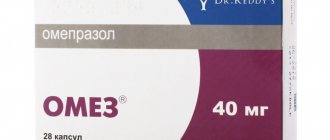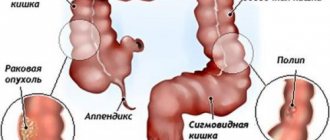Release form and composition
The product is based on a substance that affects the synthesis of hydrochloric acid - omeprazole. The main effect is to restore the processes of juice secretion, reduce acidity, and prevent negative effects on the stomach receptors from the outside.
Another active component - domperidone - is aimed at increasing the tone of the lower gastrointestinal sphincter, normalizing the process of bowel movements and restoring intestinal motility. The drug is available in 3 forms - capsules, powders for suspensions and infusions. Based on this, they have different auxiliary components.
Capsules
There are 3 types, depending on the content of the active substance omeprazole - 10, 20, 40 mg. They are also divided into types based on the capsule shell:
- the usual coating consists of hypromellose 6 cps;
- enteric coating - sodium hydroxide, methacrylic acid, macrogol 6000, methyl methacrylate copolymer, titanium dioxide, talc;
- gelatin capsules: gelatin, E122 (azorubine coloring), methyl parahydroxybenzoate, water, propyl parahydroxybenzoate.
Auxiliary components of internal filling:
- sodium hydrogen phosphate;
- mannitol;
- sodium lauryl sulfate;
- sucrose;
- lactose;
- hypromellose 6 cps.
Inside the capsules there are white granules, the body is colorless, the cap is pink or purple. Each part of the capsule is marked in black with the name of the drug in English (OMEZ). Capsule tablets are packaged in aluminum strips of 10 units. One cardboard package may contain 1 or 3 blisters, 10 and 30 capsules, respectively.
Insta powder
Purpose: preparation of a suspension for oral administration (orally). The powdery mixture has a white color, a mint smell, and is packaged in bags of 5, 10, 20, 30 pieces per package. The content of the active substance omeprazole is 20 mg. Additional Ingredients:
- sodium bicarbonate;
- mint flavor;
- sucrose;
- xylitol;
- gum.
Before consumption, the powder is diluted with purified water.
Powder lyophilisate
Purpose: preparation of an infusion solution for intravenous drip administration. It is produced in the form of a powder, packaged in colorless glass bottles, and packaged in cardboard boxes. The content of the active substance is 40 mg. Auxiliary components:
- sodium hydroxide;
- edetate disodium.
Before use, add a 5% glucose (dextrose) solution to the contents of the bottle (the drug should not contain preservatives).
pharmachologic effect
The main effect of the drug Omez is associated with the inhibition of hydrochloric acid. If the drug is taken daily, the secretion of glands in the stomach decreases for a long period of time. This can lead to the formation of benign glandular cysts, which subsequently resolve on their own. Due to a decrease in the concentration of hydrochloric acid in the blood serum, the amount of gastrin and chromogranin A increases, therefore it is prohibited to take the drug during malignant processes.
Pharmacodynamics
The active substance is localized in the secretory tubules of parietal cells on the gastric mucosa, that is, in an acidic environment, against which the activation and inhibition of the proton pump (H+/K+-ATPase enzyme) occurs. The mechanism of action has its own characteristics:
- Omeprazole affects the synthesis of hydrochloric acid in a dose-dependent manner, therefore, basal and stimulated acid secretion is inhibited, regardless of the stimulus factor.
- The substance affects the production of gastric juice, which leads to rapid inhibition of daytime and nighttime hydrochloric acid.
- If you take the dosage form at a dosage of 20 mg, then throughout the day the acidity level decreases by 80-90%, and the concentration of hydrochloric acid - by 60-70%.
- The rate of action of drugs most often depends on the level of concentration of the active substance in the blood plasma. When taking Omez, the inhibition process is based on the pharmacokinetic AUC curve, that is, concentration and time.
- Omeprazole additionally has bactericidal properties against the bacterium Helicobacter pylori, especially when taken simultaneously with antibiotics.
- The drug promotes the regeneration of damaged cells and tissues of the mucous membranes of the gastrointestinal tract, therefore it is actively prescribed for ulcerative lesions.
Pharmacokinetics
The active substance is absorbed quickly - maximum plasma concentration is reached after 60-120 minutes. The absorption process is noted in the small intestine, the completion time is from 3 to 6 hours. The bioavailability of the drug is 40% with a single dose. If you drink the capsules/powder a second time, the level of bioavailability increases. However, food intake does not affect this in any way. Omeprazole binds to plasma proteins by 90-97% and is quickly distributed throughout the body.
Features of metabolism and excretion from the body:
- The substance is metabolized via systemic cytochrome P450 in the liver.
- During metabolism, inactive metabolites are formed.
- The expressed CYP2C19, which is responsible for the synthesis of hydroxyomethprazole (the main metabolite), completely affects metabolism.
- The effect of CYP3A4 is also important (a specific isoform forms the omeprazole sulfone).
- The active substance does not inhibit CYP enzymes.
- The half-life is approximately 40 minutes (in case of liver failure, the time increases to 3 hours).
- Blood plasma clearance is 0.3-0.6 l/min.
- The substance is excreted 70% through urinary fluid, 30% through feces from bile secretion.
- When taken once a day, the drug does not accumulate in the blood.
- When taken twice, the AUC of the substance increases, but the concentration level depends on the dosage of the drug. This suggests a nonlinear relationship between time and dose. The reason for this is a decrease in presystemic metabolism and clearance due to suppression of the CYP2C19 enzyme.
- Omeprazole AUC may increase due to liver disease as metabolism changes.
- With dysfunctional abnormalities in the renal system, the rate of metabolism and excretion from the body does not change.
- The metabolism of active substances slows down in old age, starting from 75 years of age.
Omez D (N30)
MINISTRY OF HEALTH OF THE RUSSIAN FEDERATION INSTRUCTIONS for the use of the medicinal product for medical use OMEZ® D
Registration number: LSR-001303/08 Trade name of the drug: Omez® D International nonproprietary or generic name: domperidone + omeprazole Dosage form : capsules Composition: one capsule contains: active ingredients: domperidone 10.00 mg, omeprazole 10.00 mg (in in the form of enteric-coated pellets (8.5% w/v 117.65 mg)*; excipients: microcrystalline cellulose (Avicel pH 102) 65.00 mg, magnesium stearate 6.00 mg, colloidal silicon dioxide 2.00 mg , sodium carboxymethyl starch 3.50 mg, sodium lauryl sulfate 0.50 mg, talc 3.00 mg *composition of omeprazole pellets (8.5% w/v): active ingredient: omeprazole 10.00 mg; excipients: mannitol 23.53 mg, sucrose 32.32 mg, sodium dihydrogen orthophosphate 1.53 mg, sodium lauryl sulfate 0.32 mg, lactose 4.71 mg, calcium carbonate 4.71 mg, hypromellose 10.00 mg, propylene glycol 0.47 mg, methacrylic acid ( 1-30 D 55) 23.53 mg, polysorbate (Tween-80) 0.21 mg, diethyl phthalate 0.94 mg, sodium hydroxide 0.21 mg, cetyl alcohol 0.47 mg, starch 4.71 mg composition empty solid gelatin capsule: cover: indigo karmin 1.000%, carmosine 5,000%, dioxide titanium 1.998%, methyl parahydrocybenzoate (methylparaben) 0.800%, propyl parahydrogybenzoate 0.200%, sodium lauryl sulfate 0.0834%, gelatin qs up to 100%, water 14.5.5.5.5.5.5.5.5.5.5.5.5.5.5.5.5. ±1.5%; body: titanium dioxide 2.166%, methyl parahydroxybenzoate (methylparaben) 0.800%, propyl parahydroxybenzoate (propylparaben) 0.200%, sodium lauryl sulfate 0.0834%, gelatin qs up to 100%, water 14.5±1.5%.
Pharmacotherapeutic group: reflux esophagitis combined treatment (proton pump inhibitor + central dopamine receptor blocker).
ATX Code: A02BX Description Hard gelatin capsule No. 2 with a light purple cap and a white body with the inscription “Omez D” and the DR.REDDY'S logo on the capsule shell containing white or almost white pellets, white or almost white particles and powder.
Pharmacological properties Pharmacodynamics
Domperidone Increases the duration of peristaltic contractions of the antrum of the stomach and duodenum, accelerates gastric emptying if this process slows down, increases the tone of the lower esophageal sphincter, and eliminates the development of nausea and vomiting. Stimulates the release of prolactin from the pituitary gland. The antiemetic effect may be due to a combination of peripheral (gastrokinetic) action and antagonism of dopamine receptors in the trigger zone of the brain. Domperidone has no effect on gastric secretion. Domperidone does not penetrate the blood-brain barrier well, so the use of domperidone is rarely accompanied by the development of extrapyramidal side effects, especially in adults.
Omeprazole Inhibits the enzyme H+/K+-ATPase (“proton pump”) in the parietal cells of the stomach and thereby blocks the final stage of hydrochloric acid synthesis. This leads to a decrease in the level of basal and stimulated secretion, regardless of the nature of the stimulus. After a single dose of the drug orally, the effect of omeprazole occurs within the first hour and continues for 24 hours, the maximum effect is achieved after 2 hours. After stopping the drug, secretory activity is completely restored after 3 to 5 days. Due to a decrease in the secretion of hydrochloric acid, the concentration of chromogranin A increases (see section “Special instructions”).
Pharmacodynamic rationale for the combination Omeprazole suppresses the secretion of hydrochloric acid, domperidone increases the tone of the lower esophageal sphincter and accelerates gastric emptying, thereby reducing the activity of aggressive factors of gastric juice and the reflux of gastric contents into the esophagus. Pharmacokinetics
Domperidone Absorption. After oral administration, domperidone is rapidly absorbed. It has low bioavailability (about 15%). Reduced acidity of gastric contents reduces the absorption of domperidone. The maximum concentration in plasma is reached after 1 hour. Distribution. Domperidone is widely distributed in various tissues; its concentration in brain tissue is low. Communication with plasma proteins is 91-93%. Metabolism. Subject to intensive metabolism in the intestinal wall and liver. Excretion. Excreted through the intestines (66%) and kidneys (33%), unchanged, 10% and 1% of the dose are excreted, respectively. The half-life is 7-9 hours; in cases of severe renal failure, it is prolonged.
Omeprazole Absorption and distribution. Omeprazole is rapidly absorbed from the gastrointestinal tract (GIT), maximum plasma concentration is achieved after 0.5-1 hour. Bioavailability is 30-40%. Plasma protein binding is about 90%. Metabolism and excretion. Omeprazole is almost completely metabolized in the liver. It is an inhibitor of the CYP2C19 isoenzyme. The half-life is 0.5-1 hour. Excreted by the kidneys (70-80%) and bile (20-30%). In chronic renal failure, excretion decreases in proportion to the decrease in creatinine clearance. In elderly patients, excretion decreases and bioavailability increases. In case of liver failure, bioavailability is 100%, half-life is 3 hours.
Indications for use - Dyspepsia associated with delayed gastric emptying, gastroesophageal reflux, esophagitis (feeling of fullness in the epigastrium, feeling of bloating, pain in the upper abdomen; belching, flatulence; nausea, vomiting; heartburn with or without reflux of gastric contents into the oral cavity); - To relieve symptoms of nausea, vomiting, dyspepsia, heartburn, including those associated with gastritis, gastric and duodenal ulcers or gastroesophageal disease.
Contraindications Hypersensitivity to domperidone, omeprazole, substituted benzimidazoles or other components included in the drug ; deficiency of lactase, sucrase/isomaltase, lactose intolerance, fructose intolerance, glucose-galactose malabsorption; gastrointestinal bleeding; mechanical intestinal obstruction, perforation of the stomach or intestines, prolactin-secreting tumor of the pituitary gland (prolactinoma); children under 12 years of age with a body weight of less than 35 kg, moderate to severe liver failure, pregnancy, breastfeeding, simultaneous use of drugs that increase the QT interval and inhibitors of the CYP34A isoenzyme; simultaneous use with erlotinib, posaconazole, nelfinavir, ata after navir, fluconazole, voriconazole, clarithromycin, amiodarone, telithromycin; ketoconazole, erythromycin; severe electrolyte disturbances or heart disease such as chronic heart failure. With caution - renal failure; the presence of “alarming symptoms: significant loss of body weight, repeated vomiting, vomiting with blood, difficulty swallowing, change in the color of stool (tarry stools), and others (see section “Special instructions”); deficiency of vitamin B12 (cyanocobalamin); osteoporosis; simultaneous use with clopidogrel, warfarin, itraconazole, digoxin, cilostazol, diazepam, St. John's wort preparations (see section "Interaction with other drugs")
Use during pregnancy and breastfeeding The use of the drug during pregnancy and breastfeeding is contraindicated.
Method of administration and dosage : Orally, without chewing, with a small amount of water, 1 capsule 2 times a day, 15-20 minutes before meals. It is recommended to take the drug regularly at a certain time. It is recommended to take the minimum effective dose. In patients with mild hepatic impairment, no dose adjustment is required. The drug is contraindicated in patients with moderate to severe liver failure.
Side effects The frequency of side effects is classified according to the recommendations of the World Health Organization: very often (≥ 1/10), often (≥ 1/100, ≤ 1/10), infrequently (≥ 1/1000, ≤ 1/100), rarely (≥ 1/10000, ≤ 1/1000), very rare, (< 1/10000), frequency unknown - based on available data, it is not possible to determine the frequency of occurrence.
Domperidone From the gastrointestinal tract: rarely - gastrointestinal disorders, including transient intestinal spasms; very rarely - diarrhea. From the nervous system: very rarely - extrapyramidal disorders, convulsions, increased excitability and irritability, drowsiness, (in adults the above symptoms are extremely rare), headache. Extrapyramidal disorders are usually reversible and disappear when domperidone therapy is discontinued. From the cardiovascular side: frequency unknown - ventricular arrhythmia, prolongation of the QT interval, ventricular tachycardia of the "pirouette" type, sudden coronary death (see section "Special instructions"). From the skin and subcutaneous tissues: very rarely - skin rash, itching of the skin, urticaria. From the immune system: very rarely - allergic reactions, including anaphylaxis, anaphylactic shock, angioedema, Other: rarely - hyperprolactinemia, galactorrhea, gynecomastia, amenorrhea; very rarely - changes in liver function tests; Omeprazole From the blood and lymphatic system: rarely - leukopenia, thrombocytopenia; very rarely - agranulocytosis, pancytopenia. From the immune system: rarely - hypersensitivity reactions: fever, angioedema, anaphylactic reaction/anaphylactic shock. Metabolism and nutrition: rarely – hyponatremia; very rarely - hypomagnesemia. Mental disorders: infrequently – insomnia; rarely – increased excitability; confusion, depression; very rarely – aggressiveness, hallucinations. From the nervous system: often – headache; uncommon – dizziness, paresthesia, drowsiness; rarely – taste disturbance. From the side of the organ of vision: rarely – blurred vision. Hearing and labyrinthine disorders: uncommon – vertigo. From the respiratory system, chest and mediastinal organs: rarely – bronchospasm. From the gastrointestinal tract: often - abdominal pain, constipation, diarrhea, flatulence, nausea, vomiting; rarely - dry mouth, stomatitis, gastrointestinal candidiasis, microscopic colitis. From the liver and biliary tract: infrequently - increased activity of liver enzymes; rarely – hepatitis (including with jaundice); very rarely - liver failure, encephalopathy in patients with previous liver diseases. From the skin and subcutaneous tissues: infrequently - dermatitis, itching, rash, urticaria; rarely – alopecia, photosensitivity reaction; very rarely - erythema multiforme, Stevens-Johnson syndrome, toxic epidermal necrolysis. From the musculoskeletal and connective tissue side: infrequently - fractures of the hip, wrist bones and vertebrae; rarely – arthralgia, myalgia, very rarely – muscle weakness. From the kidneys and urinary tract: rarely – interstitial nephritis. From the genital organs and breast: very rarely - gynecomastia. General disorders: uncommon – malaise, peripheral edema; rarely – increased sweating. Cases of formation of gastric glandular cysts have been reported during long-term treatment with proton pump inhibitors (a consequence of inhibition of hydrochloric acid secretion, which is benign and reversible).
Overdose of Domperidone Symptoms: increased excitability, drowsiness, convulsions, disorientation and extrapyramidal reactions. Treatment: symptomatic, there is no specific antidote. Gastric lavage, taking activated charcoal, if extrapyramidal reactions occur, use anticholinergic, antiparkinsonian drugs. Due to possible prolongation of the QT interval, the electrocardiogram should be monitored. Omeprazole Symptoms: nausea, vomiting, dizziness, abdominal pain, diarrhea, headache, apathy, depression, confusion, flatulence, tachycardia. Treatment: symptomatic. If necessary, gastric lavage, activated charcoal, hemodialysis is not effective enough.
Interactions with other drugs Domperidone Interactions with the following drugs may increase the risk of QT prolongation: Contraindicated combinations: drugs that prolong the QT interval: class IA antiarrhythmic drugs (eg, disopyramide, hydroquinidine, quinidine), class III antiarrhythmic drugs (eg, amiodarone, dofetilide , dronedarone, ibutilide, sotalol), antipsychotics (eg, haloperidol, pimozide, sertindole), antidepressants (eg, citalopram, escitalopram), antibiotics (erythromycin, levofloxacin, moxifloxacin, spiramycin), antifungals (eg, pentamidine), antimalarials medications (eg, halofantrine, lumefantrine), gastrointestinal medications (eg, cisapride, dolasetron, prucalopril), antihistamines (eg, mechitazine, mizolastine), anticancer medications (eg, remifene, vandetanib , vincamine), other medications (for example, bepridil, difemanil methyl sulfate, methadone), potent CYP3A4 inhibitors (protease inhibitors, azole antifungals, some macrolide antibiotics (erythromycin, clarithromycin, telithromycin)). Not recommended combinations: moderate CYP3A4 inhibitors (diltiazem, verapamil, some macrolide antibiotics). Combinations that should be used with caution: drugs that cause bradycardia and hypokalemia, as well as azithromycin and roxithromycin. Cimetidine, sodium bicarbonate, and other antacid and antisecretory drugs reduce the bioavailability of domperidone. Anticholinergics may counteract the effects of domperidone. Increase the concentration of domperidone in plasma: azole antifungals, antibiotics from the macrolide group, HIV protease inhibitors, nefazodone. Domperidone is compatible with the use of neuroleptics, dopaminergic receptor agonists (bromocriptine, levodopa),
Omeprazole When omeprazole is used together with some antiretroviral drugs, such as atazanavir and nelfinavir, a decrease in their plasma concentration is observed. In this regard, the combined use of omeprazole with atazanavir and nelfinavir is contraindicated. With simultaneous use of omeprazole and saquinavir/ritonavir, an increase in saquinavir plasma concentrations was observed. The bioavailability of digoxin when used simultaneously with omeprazole increases by 10% (adjustment of the dosage regimen may be required). Caution should be exercised when these drugs are used concomitantly in elderly patients. With simultaneous use of omeprazole with clopidogrel, a decrease in the antiplatelet effect of the latter is observed. Therefore, the combined use of omeprazole and clopidogrel should be avoided . Like other drugs that reduce gastric acidity, treatment with omeprazole may lead to decreased absorption of ketoconazole, itraconazole, posaconazole, erlotinib, iron supplements and cyanocobalamin. should be avoided . When used simultaneously with omeprazole, it is possible to increase the plasma concentration and increase the half-life of warfarin, diazepam, phenytoin, cilostazol, imipramine, clomipramine, citalopram, hexobarbital, disulfiram, as well as other drugs metabolized in the liver with the participation of the CYP2C19 isoenzyme (a dose reduction of these drugs may be required ). When methotrexate was co-administered with proton pump inhibitors, a slight increase in plasma methotrexate concentrations was observed in some patients. When treated with high doses of methotrexate, omeprazole should be temporarily discontinued. With the simultaneous use of omeprazole and tacroliamus, an increase in the concentration of tacrolimus in the blood plasma was noted, which may require adjustment of its dose. When omeprazole is taken together with inhibitors of the CYP2C19 and CYP3A4 isoenzymes (such as clarithromycin, erythromycin, voriconazole ) , the concentration of omeprazole in the blood plasma increases. Inducers of the CYP2C19 and CYP3A4 isoenzymes, such as rifampicin, preparations of St. John's wort (Hipericum perforatum), when used together with omeprazole, can lead to a decrease in the concentration of omeprazole in the blood plasma by accelerating the metabolism of omeprazole. Co-administration of omeprazole with amoxicillin or metronidazole does not affect the concentration of omeprazole in the blood plasma. There was no effect of omeprazole on antacids, theophylline, caffeine, quinidine, lidocaine, propranolol, ethanol.
Special instructions Before starting therapy, it is necessary to exclude the presence of a malignant process, since treatment, masking symptoms, can delay the correct diagnosis. Due to the decrease in hydrochloric acid secretion by omeprazole, the concentration of chromogranin A (CgA) increases. Increased concentrations of CgA in blood plasma may affect the results of examinations to detect neuroendocrine tumors. To prevent this effect, it is necessary to temporarily stop taking omeprazole 5 days before the CgA concentration test. Proton pump inhibitors, especially when used in high doses and long-term use (>1 year), may moderately increase the risk of hip, wrist, and vertebral fractures, especially in patients who are elderly or have other risk factors. Severe hypomagnesemia, manifested by symptoms such as fatigue, delirium, convulsions, dizziness and ventricular arrhythmia, has been reported in patients receiving omeprazole for at least three months. In most patients, hypomagnesemia was relieved after discontinuation of proton pump inhibitors and administration of magnesium supplements. In patients who are planning long-term therapy or are prescribed omeprazole with digoxin or other drugs that can cause hypomagnesemia (for example, diuretics), magnesium levels should be assessed before starting therapy and monitored periodically during treatment. Omeprazole, like all drugs that reduce acidity, can lead to decreased absorption of vitamin B12 (cyanocobalamin). This must be remembered in patients with a reduced supply of vitamin B12 in the body or with risk factors for impaired absorption of vitamin B12 during long-term therapy. Patients taking drugs that reduce the secretion of gastric glands for a long time are more likely to experience the formation of glandular cysts in the stomach, which go away on their own with continued therapy. These phenomena are caused by physiological changes resulting from inhibition of hydrochloric acid secretion. Reduced secretion of hydrochloric acid in the stomach under the influence of proton pump inhibitors or other acid-inhibiting agents leads to an increase in the growth of normal intestinal microflora, which in turn may lead to a slight increase in the risk of developing intestinal infections caused by bacteria of the genus Salmonella spp. and Campylobacter spp., and also possibly Clostridium difficile in hospitalized patients. Domperidone may cause QT prolongation and torsade de pointes (TdP). These adverse reactions were observed mainly in patients with risk factors, with severe electrolyte disturbances, or concomitantly taking drugs that prolong the QT interval. Some studies have shown that the use of domperidone may lead to an increase in ventricular arrhythmias or sudden coronary death (especially in patients over 60 years of age and in patients taking the drug in daily doses of more than 30 mg, as well as in patients taking concomitant drugs QT interval prolongers or CYP3A4 inhibitors). It is not recommended to use domperidone preparations to prevent nausea and vomiting after anesthesia. The use of domperidone and other drugs that can cause prolongation of the QT interval is contraindicated in patients who experience prolongation of cardiac conduction intervals, especially the QT interval, in patients with severe electrolyte disturbances (hypo- and hyperkalemia, hypomagnesemia) or in patients with heart disease. such as chronic heart failure. It has been shown that the presence of electrolyte disturbances (hypo- and hyperkalemia, hypomagnesemia) and bradycardia in a patient may increase the risk of developing arrhythmia. You should stop taking the drug if any symptoms occur that may be associated with cardiac arrhythmias. Domperidone drugs enhance the effect of antipsychotics when used simultaneously with them. With the simultaneous use of domperidone drugs with dopaminergic receptor agonists (bromocriptine, levodopa), there is an inhibition of the unwanted peripheral effects of the latter, such as indigestion, nausea and vomiting, without affecting their central effects. It is recommended to take the drug in the minimum effective dose.
Impact on the ability to drive vehicles and machinery Care should be taken when driving vehicles and engaging in other potentially hazardous activities that require increased concentration and speed of psychomotor reactions due to the risk of developing adverse reactions that may affect these abilities.
Release form Capsules. 10 capsules per aluminum foil strip. 3 strips and instructions for use in a cardboard box.
Storage conditions Store in a dry place, protected from light, at a temperature not exceeding 25°C. Keep out of the reach of children.
Shelf life: 2 years. Do not use after the expiration date indicated on the package.
Conditions of release By prescription. Manufacturer Torrent Pharmaceuticals Ltd., India Torrent Pharmaceuticals Ltd., India Torrent House, Off Ashram Road, Ahmedabad 380 009, India Torrent House, Off Ashram Road, Ahmedabad 380 009, India
Manufacturing address : Torrent Pharmaceuticals Ltd. Torrent Pharmaceuticals Ltd., Indrad-382721, Dist. Mehsana, India / Indrad-382721, Dist. Mehsana, India
Information about complaints and adverse reactions should be sent to the following address: Representative office of Torrent Pharmaceuticals Ltd.: Moscow 117418 st. Novocheremushkinskaya, 61 tel., fax e-mail
Indications for use of Omez
Since the drug is based on suppressing the secretion of hydrochloric acid, Omez has a wide range of applications:
- duodenal and gastric ulcers;
- erosion;
- gastritis with high acidity;
- damaged esophagus in the lower part;
- gastroesophageal reflux disease;
- esophagitis reflux;
- gastrinoma;
- heartburn;
- infection of the mucous membranes of the stomach and intestines;
- Zollinger-Ellison syndrome;
- pancreatitis;
- mastocytosis;
- long-term use of non-steroidal anti-inflammatory drugs, against the background of which the mucous membranes of the gastrointestinal organs are damaged.
Quite often, Omez is prescribed a couple of hours before surgery, thereby preventing the risk of acidic gastric juice entering the respiratory system.
Indications
Omeprazole has wide indications for diseases of the upper gastrointestinal tract. The drug is usually prescribed to adults and children over 5 years of age in the following cases:
- stomach and duodenal ulcers;
- erosive and ulcerative esophagitis;
- NSAID gastropathy (ulcerative process resulting from potentiated use of non-steroidal anti-inflammatory drugs);
- Zollinger-Ellinson syndrome;
- systemic mastocytosis;
- polyendocrine adenomatosis;
- stress, aspirin and chronic duodenal ulcers of the digestive tract;
- therapy for reflux esophagitis (including long-term treatment of patients with an inactive form of the disease);
- treatment of symptomatic GERD;
- treatment of ulcerogenic adenoma of the pancreas;
- eradication of H. pylori in peptic ulcer disease (in combination with appropriate antibacterial agents);
- to eliminate uncomplicated heartburn that lasts more than 2 days during the week.
Methods of taking Omez
Omez is prescribed for various diseases. In each individual case, there is a specific method of using the drug.
Capsules:
- For reflux esophagitis, take 20 mg once a day (1 capsule of the appropriate dosage of the active substance). The course of admission is six months.
- Acute stomach ulcer: 1 or 2 capsules per day (no more than 40 mg) for 1-2 months, depending on the degree of damage and advanced stage of the disease.
- Duodenal ulcer during exacerbation: once a day, 20 mg. The duration of treatment varies from 14 to 30 days. In particularly advanced cases, the daily dose increases to 40 mg.
- For infection with Helicobacter pylori: the daily dose is 40 mg, divided into 2 doses. The course of therapy is a week. It is mandatory to take antibacterial medications.
- Erosion, use of non-steroids, damage to the mucous membranes of the gastrointestinal tract: 20 mg per day for one or two months.
- For Zollinger-Ellison syndrome, the minimum dosage is 60 mg. Depending on the acidity level, the norm can be increased to 120 mg. Number of doses: twice a day.
Capsules are washed down with water and taken at any time of the day, regardless of meals.
Infusion solution:
- The solution is administered intravenously.
- The dosage depends on the level of damage.
- The minimum norm is 40 mg. The drug is administered once a day.
- The maximum dose is 60-80 mg. Administration is carried out twice a day.
- The duration of the course of treatment depends on the speed of elimination of unpleasant symptoms, after which capsules or suspensions are prescribed.
Powder for suspensions:
- pour 1 sachet of powder into a glass;
- add 2 tbsp. l. clean water;
- to stir thoroughly;
- drink half an hour before meals;
- daily dosage - 20-40 mg.
Omez for gastritis
Gastritis is divided into 2 main forms - with low and high acidity. Since Omez reduces the level of acid in the gastrointestinal tract, it is prohibited to take it with low acidity, as this will further aggravate the patient’s condition. But with increased acidity, the drug, on the contrary, is recommended for use. With this form of gastritis, frequent heartburn, belching, nausea, bloating, and aching pain are noted. All these signs appear due to the release of hydrochloric acid, which affects the mucous membranes. When taking Omez, acidity is significantly reduced, an alkaline (favorable) environment is formed, which relieves pain, eliminates belching and heartburn, and restores digestion.
There is also an atrophic type of gastritis, in which the walls of the mucous membranes of the stomach atrophy. Omez regenerates (heals) damaged epithelium.
Rules for taking capsules and powder for suspensions:
- The daily dose of the drug is 20 mg.
- The duration of the course is from 10 to 15 days.
- For reflux gastritis, the duration of treatment is 30-60 days.
- In case of severe pain and in the acute phase, the dosage is increased to 40 mg.
- For chronic gastritis, therapy lasts 3-4 months.
An infusion solution is administered if it is impossible to relieve symptoms using capsules.
Omez for heartburn
Heartburn is a symptom of many diseases of the gastrointestinal tract, in which the acidity of gastric juice increases. Omez is indicated for use precisely in such cases. If heartburn occurs due to the consumption of certain foods, then it is not advisable to take the drug, since the etiology of the symptom remains unknown. An infusion solution is not used to combat heartburn, only a capsule form and suspension.
Features of application:
- If heartburn occurs occasionally, it is enough to take the drug 10-20 mg.
- If the symptom persists, the dosage ranges from 40 to 120 mg, based on the severity of the underlying disease.
- The minimum duration of therapy is 4 days, the maximum is 2 weeks.
- It is advisable to take the medicine 3-4 hours before bedtime, before dinner.
Omez for pancreatitis
With pancreatitis, enzymatic substances produced by the body are activated in the pancreas, and not in the duodenum, as in a healthy person. This promotes tissue destruction, against the background of which cells affected by toxins penetrate into the bloodstream, which leads to dysfunction of the cardiovascular system, lungs, and kidneys. In addition, the main complication of pancreatitis is gastroesophageal reflux disease. Omez helps reduce the load on the pancreas by inhibiting the process of activation of enzymes that cause pancreatitis. The drug suppresses acidity, reduces intrapancreatic pressure, and therefore relieves pain.
How to take capsules and suspension for pancreatitis:
- in the first one and a half to two months, drink 20 mg twice a day;
- Omez is subsequently used as maintenance therapy, 1 capsule per day (20 mg).
Contraindications for Omez
When is it prohibited to use Omez:
- oncological neoplasms in the gastrointestinal tract (the active substance promotes tumor growth);
- calcium deficiency (omeprazole releases this trace element from the body);
- infection with salmonella or campylobacter (the active substance creates a favorable environment for these bacteria);
- liver failure (in this case the metabolism of the drug slows down);
- age up to 2 years (capsules, suspension);
- age up to 18 years (intravenous administration);
- individual intolerance to components (allergy);
- reduced acidity of gastric juice;
- intestinal obstruction;
- internal bleeding;
- period of pregnancy and breastfeeding;
- simultaneous use of certain groups of drugs.
Special instructions for the use of the drug Omez d
Before starting and after completing therapy with Omez D, it is necessary to conduct an endoscopic examination to exclude a malignant process, since treatment with omeprazole can mask its symptoms and delay correct diagnosis. During pregnancy, the drug is used if the expected benefit to the mother outweighs the potential risk to the fetus. If it is necessary to prescribe the drug during breastfeeding, it is advisable to stop breastfeeding. During treatment with the drug, special care should be taken when driving vehicles or working with potentially dangerous mechanisms.
Side effects of Omez
Negative reactions occur against the background of uncontrolled use of Omez, in the presence of contraindications. What can happen:
- Immune system: sometimes angioedema, fever, anaphylactic shock (against the background of an allergic reaction) occur.
- Endocrine system: hypocalcemia, hypomagnesemia, hypokalemia, hyponatremia (deficiency of these substances, as they are excreted from the body in large quantities) are occasionally observed.
- Psyche: depression, insomnia, confusion, excitability. Very rarely, hallucinations begin and aggressiveness appears.
- Nervous system: headache, dizziness, increased drowsiness, impaired taste.
- Visual apparatus: decreased visual acuity, temporary loss of clarity of vision.
- Labyrinthine reactions, auditory organs: ringing in the ears, sensation of objects or body spinning, poor hearing.
- Respiratory system: bronchospasm.
- Gastrointestinal organs: rarely - colitis, stomatitis, dry mouth, change in the shade of the tongue. Very rarely - cyst formation, gastrointestinal candidiasis. Quite often - pain, diarrhea or constipation, nausea and vomiting, flatulence.
- Liver, biliary tract: jaundice, hepatitis, liver failure.
- Skin: rashes, itching, burning, dermatitis, urticaria, hyperemia (redness). Extremely rare: toxic necrolysis of the epidermis, severe erythema (Stevens-Johnson disease).
- Connective tissues, musculoskeletal: myalgia, arthralgia, muscle weakness, fractures due to osteoporosis.
- Kidneys: interstitial nephritis.
- With intravenous administration, swelling may occur at the puncture site. Sometimes sweating increases and weakness appears.
To avoid adverse reactions, be sure to consult a doctor, do not self-medicate and strictly adhere to the dosages prescribed by the gastroenterologist.
Side effects of the drug Omez d
most patients tolerate the drug well. With prolonged use, skin reactions may occur (skin rash, itching, urticaria, erythema multiforme), dry mouth, diarrhea, constipation, intestinal colic, headache, photosensitivity, alopecia, Quincke's edema, dizziness, parasthesia, drowsiness, insomnia, blurred vision , disturbance of taste, agitation, depression, leukopenia, thrombocytopenia, pancytopenia, agranulocytosis, myalgia, arthralgia, bronchospasm, interstitial nephritis, very rarely - galactorrhea, gynecomastia. Domperidone may cause the development of extrapyramidal reactions, especially in young and elderly patients.
Interaction
Omez does not interact with all dosage forms, so you should consult a doctor before consuming it. You need to pay attention to the following facts:
- Products based on substances with pH-dependent absorption, as the level of absorption of beneficial substances decreases. These are the active ingredients: itraconazole, ketoconazole, cyanocobalamin, iron, erlotinib, posaconazole.
- When taking Omez and Digoxin simultaneously, the bioavailability of the latter drug increases, which will require adjustment of the daily dosage.
- When using Clopidogrel, there is a decrease in the level of inhibition of platelet aggregation and a decrease in exposure to clopidogrel metabolites.
- Antiretroviral drugs. Omeprazole increases the pH value, so these drugs are poorly absorbed by the body. In addition, the concentration of the active substances of the group decreases and the duration of action of omeprazole slows down. These are drugs such as Nelfinavir, Atazanavir, Saquinavir.
- Omeprazole increases the amount of the active substance of the drug Tacrolimus and Methotrexate, so adjustment of the dose taken is necessary.
- Drugs whose metabolism depends on the CYP2C19 isoenzyme: Hexobarbital, Warfarin, Diazepam, Disulfiram, Phenytoin, Imipramine, Cilostazol, Citalopram, Clomipramine. As in the previous case, the concentration of substances in the blood plasma increases significantly and the elimination time increases.
- Drugs with inhibitors of the isoenzyme CYP2C19, CYP3A4: Clarithromycin, Erythromycin, Variconazole. The metabolism of Omez slows down, the concentration of the active substance in the blood plasma increases.
- When taking Omez simultaneously and inducers of the CYP2C19 and CYP3A4 isoforms, metabolic processes are accelerated, increasing the amount of omeprazole. Preparations: Rifampicin, products based on St. John's wort.
- There is no interaction with the following medications: Diclofenac, Propranolol, Theophylline, Metronidazole, Amoxicillin, Quinidine, Lidocaine, Estradil.
Interactions of the drug Omez d
Antacids slow down and reduce the absorption of the drug, so they should be taken no earlier than 2 hours after taking Omez D. Since omeprazole is metabolized in the liver through the cytochrome P450 system, it should be prescribed with caution simultaneously with diazepam, phenytoin, warfarin, propranolol, prednisolone , theophylline (while omeprazole may reduce their elimination, which requires a reduction in the doses of these drugs). With simultaneous use of omeprazole and clarithromycin, their concentration in the blood plasma increases. Cimetidine and sodium bicarbonate reduce the bioavailability of domperidone. Anticholinergic drugs counteract the effects of domperidone.
Omez's analogs
Analogues are drugs that are similar in principle of action or composition. They may be cheaper or more expensive than the original. Their list is quite extensive. Therefore, before purchasing a similar product, you must carefully study all the pros and cons.
Which is better: Omez or Omeprazole?
Omeprazole has an identical composition in terms of the main active ingredient, and therefore has the same therapeutic effect. Which drug should you prefer? Difference:
- The analogue is produced by a Russian pharmaceutical company, so the cost of the product is several times lower.
- Excipients differ. Both drugs contain the following: mannitol, sucrose, sodium lauryl sulfate, hypromellose. Omez contains sodium hydrogen phosphate, Omeprazole contains calcium phosphate and carbonate, polyethylene glycol, titanium dioxide, and the protective shell contains many dyes and acetic acid. It follows from this that Omez is considered safer for the body.
- The readings are completely identical.
- The release form of Omez is wider; Omeprazole is produced only in capsules of 20 and 40 mg.
- Adverse reactions with the analogue occur more often.
Which is better: Omez or Nolpaza?
Both drugs have a similar effect - they reduce the level of hydrochloric acid concentration. They have the same indications and belong to the same group, but there are differences between them:
- The active substance of Nolpaza is pantoprazole sodium (a derivative of benzimidazole), Omeza is omeprazole. The first substance is considered more modern, and therefore highly effective.
- Nolpaza is of European quality, but Omez has proven itself on the positive side for decades.
- The cost of the analogue is much higher.
- Nolpaza is produced in Slovenia, Omez - in India.
- To achieve lasting positive dynamics, Omez is used longer than Nolpaza.
Which is better: Omez or Ranitidine?
The drug Ranitidine is based on ranitidine hydrochloride. The main effect is the suppression of histamine receptors in the mucous membranes of the stomach at the cellular level. Due to this, the concentration of hydrochloric acid decreases. Therefore, the indications for Ranitidine and Omez are the same. Both drugs have proven themselves on the positive side, but the difference between them lies in the mechanism of action (Rinitidine inhibits histamine receptors, and Omez inhibits enzymes that transfer protons to the part of the body where acid is synthesized). Omez has a higher cost, but has a smaller list of contraindications.
Which is better: Omez or De Nol?
The drugs are included in the same antacid group, but De Nol is also a sorbent that has gastroprotective and antibacterial properties. It contains an active substance - tripotassium bismuth dicitrate, and Omez - omeprazole. The analogue produces substances that create a protective film on the mucous membranes of the stomach, due to which hydrochloric acid is not released. Omez helps suppress the acidic environment.
De Nol is produced in the Netherlands, Omez - in India, so the first product has a price many times higher. Since the structural features of the drugs are different, they cannot be interchangeable. Therefore, it is advisable to use them together.
Which is better: Omez or Pariet?
The drugs have different compositions, but they share the same mechanism of action. Pariet is based on rabeprazole, which affects the body in the same way as omeprazole (the active substance of Omez). Pariet is considered a new generation drug, therefore its cost is almost 10 times higher.
Other features:
- Pariet has the highest degree of bioavailability, so it can be prescribed in particularly advanced cases.
- After taking Omez, adverse reactions occur more often.
- Pariet can be used by children starting from 12 years old, Omez - from 2 years old.
- Different release forms: Omez - capsules, powders, Pariet - tablets.
Which is better: Omez or Razo?
How do the drugs differ:
- Omez contains omeprazole, Razo is based on rabeprazole.
- The analogue is available exclusively in tablet form containing 20 mg of active substance. Omez is produced in the form of various capsules, powder for infusions and suspensions. The dosage of the active ingredient is 20 and 40 mg.
- Omez acts on the body longer than Razo, since the second remedy is a drug of a new generation.
- There is no withdrawal syndrome in Razo; in rare cases, Omez experiences acid hypersecretion.
- The analogue is several times more expensive than the original. This is especially true with a long course of treatment.
Which is better: Omez or Omizak?
The drugs are almost identical - the same active ingredient, a similar mechanism of influence on hydrochloric acid, due to which the microflora of the gastrointestinal tract is normalized. Accordingly, the indications for the drugs are identical. The cost does not differ significantly, but Omez has been known on the pharmaceutical market for much longer. Omizak appeared quite recently. For this reason, it is not very popular (people are wary of innovation).
If we talk about the release form, then Omez wins significantly. It can be purchased in different dosages - 10, 20, 30 mg, in the form of powder for intravenous administration, suspension and capsules. Omizak is produced only in capsule form, there is only one packaging - 50 units per package, while Omez can be taken from 10 pieces. The shelf life of the capsules varies - for Omez - 3 years, for Omizak - only 2.
Which is better: Omez or Losek Maps?
Both drugs are pump inhibitors and are included in the same group because they are based on the same active component - omeprazole. Accordingly, the mechanism of action is similar. Losek Maps is the original, and Omez is its analogue, because the first drug began to be produced much earlier. It is produced by Sweden, and Omez is produced by India, which is why the cost varies greatly. The price of the Swedish product is 4-5 times more expensive.
Losek Maps is produced in tablets, Omez - in powder for infusions and suspensions, capsules, which is why it is very popular. In terms of effectiveness and other criteria, the drugs are completely identical, but it is believed that the quality indicators of Losek are higher.
Which is better: Omez or Rabeprazole?
Medicines differ in their active component: Omez consists of omeprazole, Rabeprazole is based on the substance of the same name. However, both components have a similar mechanism of action - they suppress and protect the stomach from hydrochloric acid. The readings are slightly different. It is more advisable to use Omez when there is an increase in acidity while taking non-steroidal medications, as well as in case of ulcerative lesions. The reason for this is its regenerative properties. Rabeprazole is more suitable for the treatment of GERD, it is considered as safe as possible, therefore in some cases it is recommended during pregnancy.
Rabeprazole is produced in the form of capsules and tablets, so it can only be taken orally. Omez is also available in the form of an infusion powder, so it is administered intravenously. The active ingredient of the analogue is more expensive.
Which is better: Omez or Nexium?
The principle of action of the drugs is the same, but there are differences:
- Nexium consists of esomeprazole, Omez - omeprazole. The difference is as follows: esomeprazole is considered a modified formula from omeprazole, that is, improved (absorbed, distributed and excreted more evenly). Despite this, practice shows that the therapeutic benefits of the modification differ only slightly.
- Nexicum is produced by the Swedes, Omez is made in India, so the analogue is considered expensive.
- The Omez release form includes powder for intravenous infusion, capsules and powder for preparing a suspension, which is undoubtedly convenient. Nexium is available in oral granules and tablets.
Which is better: Omez or Ultop?
The medications are based on an identical active substance - omeprazole, so the principle of action is the same. The difference is this:
- Manufacturer Omeza - India, Ultopa - Slovenia. Accordingly, different price criteria. The first drug is cheaper.
- Ultop is available only in capsule form and as a solution for injections, Omez - in powder for injection and oral administration, capsules.
- Omez is considered safer, so in rare cases it can be prescribed during pregnancy (if the benefits outweigh the harm).
Which is better: Omez or Emanera?
Like Nexium, Emanera consists of esomeprazole and is therefore considered a new generation drug. The analogue has a smaller list of contraindications and adverse reactions, but the effectiveness is weaker than that of Omez. Based on this, Emanera is prescribed for mild gastrointestinal diseases. The price range is relatively the same.
Analogs
Omez D has many analogues, both with omeprozole and domperidone, but only in a different combination, and based on other active substances.
Based on omeprozole:
- Ozol;
- Omealox;
- Omez;
- Omeprazole;
- Proton;
- Ultop.
Based on esomeprazole:
- Nexium;
- Nexpro;
- Pemozar;
- Esomeprazole;
- Emanera.
Based on pantoprazole:
- Panocide;
- Pangastro;
- Nolpaza;
- Control;
- Zolopent;
- Pantor et al.
For children
A few years ago, Omez was prohibited for use by children under 12 years of age. Later, scientific research was carried out, thanks to which the drug in capsules and suspensions was allowed to be used from 2 years. Lyophilisate is prescribed from the age of 18. Feature - the child’s body weight should not be less than 20 kg.
Specifics of taking Omez:
- Starting from 2 years of age, the drug is prescribed for GERD (gastroesophageal reflux disease). The daily dosage per 1 kg of baby's weight ranges from 0.7 to 3.3 mg. On average, 20 mg of active substance per day is allowed. It is recommended to take the drug once for 1-2 months.
- At 4 years of age, Omez is prescribed for ulcerative lesions and the presence of Helicobacter pylori. The daily norm is 20-40 mg.
- Omez Insta is mixed with water or natural juice.
- It is difficult for a child to swallow the capsule, so it is opened, the granules are poured into a cup, and combined with an acidified component (juice, fruit puree).
- It is strictly prohibited to use dairy and fermented milk products, carbonated water and drinks as liquids.
With alcohol
The components of Omez are inhibitors, and alcoholic beverages are ethanol-based catalysts. Alcohol substances participate in metabolism, releasing toxic products. When ethanol and toxic residues combine with the contents of Omez, a negative reaction occurs, as a result of which omeprazole ceases to inhibit hydrochloric acid. In simple terms, the effect of the drug is significantly reduced. In addition, CYP2C19 enzymes activate blocking metabolites, which increases the amount of toxic substances in the body, resulting in severe intoxication.
A person experiences the following symptoms:
- severe pain in the head;
- tremors in the arms and legs;
- nausea and vomiting;
- allergic reaction;
- hyperemia;
- nervous excitement;
- violation of movement coordination;
- diarrhea, constipation;
- bone pain;
- muscle aches;
- confusion.
Based on the above, we can conclude that alcohol is not compatible with Omez. If you have taken an alcohol-containing drink, then before drinking Omez, you must remove ethanol and its breakdown products from the body. This takes time: after drinking beer you need to wait from an hour to six, depending on the dose of alcohol taken. Wine is removed within 2 hours minimum, 17 hours maximum, vodka, cognac - 6-30 hours. You need to know that long-term use of the drug contributes to the accumulation of the active substance, so it is better to completely abstain from alcohol.
Reviews
In general, patients respond well to Omez D. The advantages include effectiveness, especially in combination with diet, and rapid relief of symptoms.
The disadvantages include the presence of side effects and the large size of the capsules. Some users have noticed that the effect of treatment occurs as part of combination therapy.
The following side effects have been observed:
- menstrual irregularities in women due to increased production of the hormone prolactin;
- stomach ache.
Read detailed reviews about Omez D at the end of the article.
Manufacturer
Omez is produced by Indian Pharmaceuticals. In Moscow there is a representative office of the organization at the address: Moscow, Ovchinnikovskaya embankment, 20/1, index 115035.
The drug Omez is considered safe for the gastrointestinal tract, but only in cases of increased acidity of gastric juice. Before use, you should undergo a comprehensive examination to determine the exact level of acidity. The dosage and duration of therapeutic measures depend on this.
Side effects
Both active substances Omez D provoke undesirable effects.
Domperidone
Domperidone has difficulty crossing the blood-brain barrier (BBB), so extrapyramidal reactions are rarely observed only if the permeability of such a barrier is increased, and in childhood.
During treatment, a number of patients report the following side effects:
- intestinal cramps;
- hyperprolactinemia, in which the concentration of prolactin in the blood increases.
Omeprozole
Side effects from the use of omeprozole:
- digestive disorders - constipation or diarrhea, flatulence;
- nausea, vomiting;
- abdominal pain;
- taste disturbances;
- hepatitis, if there is a medical history of severe illnesses and liver dysfunction;
- rarely - formation of gastric cysts;
- CNS disorders (headache, dizziness, depression, hallucinations, sleep disorders, etc.);
- muscle weakness, pain in muscles and joints;
- blood count abnormalities (decrease in the concentration of leukocytes, platelets, etc.);
- skin reactions - itching, increased sweating, hair loss, photosensitivity (sensitivity to solar radiation);
- allergic reactions, including angioedema and anaphylactic shock, bronchospasm;
- visual impairment;
- peripheral edema;
- gynecomastia (breast enlargement in men).
Since Omez D causes drowsiness and other central nervous system disorders in some patients, caution must be exercised when driving or operating other equipment that requires concentration.
Contraindications
Omez D is not used to treat children. The drug is contraindicated if you have been diagnosed with:
- bleeding of the gastrointestinal tract;
- mechanical obstruction, perforation (formation of a hole in the wall) of the stomach or intestines;
- prolactinoma (pituitary tumor);
- increased susceptibility to components.
The medicine should be used with caution in the treatment of patients with renal and hepatic insufficiency.
During pregnancy and breastfeeding
Omez D is prescribed to pregnant women with caution, and it is contraindicated for nursing mothers.
Overdose
The symptoms of an overdose of domperidone and omeprozole are different.
1. Domperidone
Symptoms of exceeding the dose are drowsiness, loss of orientation, extrapyramidal reactions - parkinsonism, dystonia, tremor, etc. Activated charcoal is prescribed as therapy ; if extrapyramidal reactions occur, the patient is given antiparkinsonian and antihistamines.
2. Omeprazole
An overdose of omeprazole is manifested by visual disturbances, drowsiness, confusion, headache, sweating, nausea, heart rhythm disturbances, and dry mouth. In this case, symptomatic treatment is carried out. Hemodialysis is ineffective.
Video on the topic: All about tablets. Omez D









